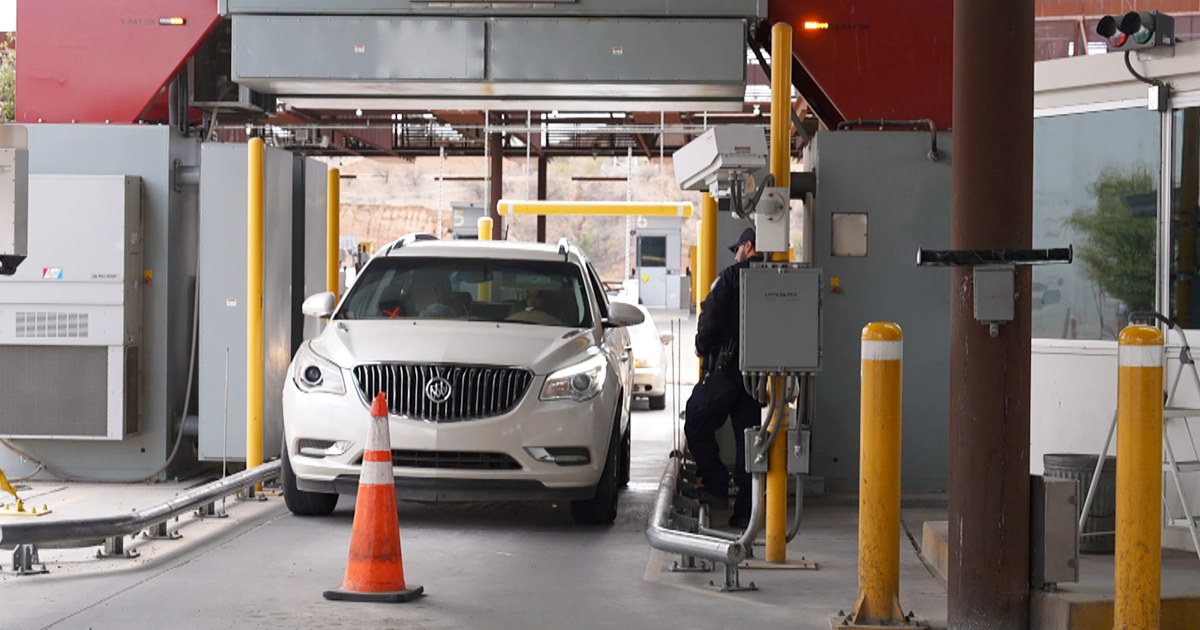By Laura Strickler, Julia Ainsley and Didi Martinez —
NBC News
Customs and Border Protection (CBP) has spent millions on high-tech scanners to detect fentanyl crossing the southern border of the United States.
But many remain stored in warehouses because Congress has not allocated funds to install them, acting CBP Commissioner Troy Miller confirmed to NBC News.
Miller gave NBC News a tour of the Nogales, Arizona port of entry, where half of the fentanyl seized at the border is detained when it enters the United States from Mexico.
Nogales officers have found
fentanyl hidden in boxes of Coca-Cola
, the bottles of which are painted black to appear as if they contain liquid, cut in half and filled with fentanyl pills.
They have also confiscated
millions of fentanyl pills stuffed into the toilet water barrel
on a commercial bus.
They have even been found in cars with small children in the back seats.
According to Miller,
More than 95% of fentanyl seized at the border is brought into the United States in personal vehicles.
NII scanners can detect drugs at the border, but some remain in warehouses due to a lack of funds to install them.NBC News
The new technology, known as non-intrusive inspection (NII), allows CBP to x-ray a percentage of cars and trucks beneath U-shaped stations that look like car washes.
Drivers do not have to get out of their vehicles to clear the checkpoint, meaning traffic can continue to flow through border checkpoints with few disruptions.
Congressional inaction
But some of the equipment purchased has not yet been put into use because Congress has not appropriated the funds necessary to install it.
The money for it was in the supplemental funding request that Republicans blocked.
“We have technology that is in the warehouse and that has been tested.
But we need approximately $300 million to install it,” Miller said.
“It's extremely frustrating.”
It is unknown exactly how much equipment is stored and where.
The contracts to buy the machines run into tens of millions of dollars.
A CBP official who spoke on condition of anonymity said that the Biden Administration's “request for supplemental funding would provide funding for civil works projects to install NII systems purchased with funds from the previous year.”
At the Mariposa port of entry in Nogales, where the new machines are installed, Miller encountered officials watching the scanners of commercial trucks as they passed through the machines.
But at the vast majority of vehicle border crossings in Nogales and elsewhere,
agents still rely on their intuition
to know if something is wrong.
Artificial intelligence is likely to increase the effectiveness of fentanyl scanning, and CBP would like to use it more, Miller added.
With it, agents could detect anomalies in trucks or suspicious changes in license plates, and other warning signs.
[Most of the fentanyl that enters through the border is brought by Americans and not undocumented immigrants, as Haley claims]
Former acting Secretary of Homeland Security Kevin McAleenan took over leadership of CBP in 2018 and 2019, just as fentanyl trafficking began to rebound.
“The vast majority of trade that crosses the border is legal.
More than 98% do not violate any US laws.
"So they're really looking for a needle in a haystack," McAleenan said.
“So what the AI can do is tell them whether this image that the agent is about to review meets what is supposed to be in that container.”
McAleenan now runs Pangiam, a Washington, D.C.-based company that CBP just awarded
$21.5 million to develop new technology
.
that can use AI to detect anomalies in border traffic.
Asked why he didn't spearhead the use of this technology when he was in charge, McAleenan responded that developing it takes many years.
“We did see the increase coming.
The efforts we undertook in 2018 reduced overdoses in 2019,” McAleenan said.
But knowing what he knows now about fentanyl, “he really would have made a point of emphasis about being aware of this and staying vigilant.”
With greater use of AI, officers would still be responsible for making the final decision to stop and search vehicles, but AI could optimize the speed and number of vehicles searched.
Currently, according to Miller, 20% of commercial vehicles are scanned and less than 5% of personal vehicles.
By the end of 2025, it wants 40% of personal cars and 70% of commercial cars to be able to be scanned.
Why aren't all vehicles inspected?
So why not scan 100% of vehicles, if it saves lives?
Miller said that with 1 million people crossing the U.S.-Mexico border each day, scanning every vehicle would “shut down legitimate commerce and travel.”
[Deaths from fentanyl increase in Mexico and it is already classified as a public health problem]
However, parents who have lost their children are asking CBP to do more.
“I think we have to close the border.
We are a superhighway,” said Theresa Guerrero of Tucson, Arizona, who lost her 31-year-old son, Jacob, in 2020 after she unknowingly ingested cocaine laced with fentanyl.
Guerrero is seeking to get photos of Jacob and two other young people from Arizona who recently died from fentanyl on a billboard that motorists would see driving from the border to Tucson.
“It saddens me every time I see a new name” of someone who has died, “especially in my home state,” he added.
“It's something that doesn't make sense.”

